Juliette Mapp and Beth Gill present brave new works in New York.
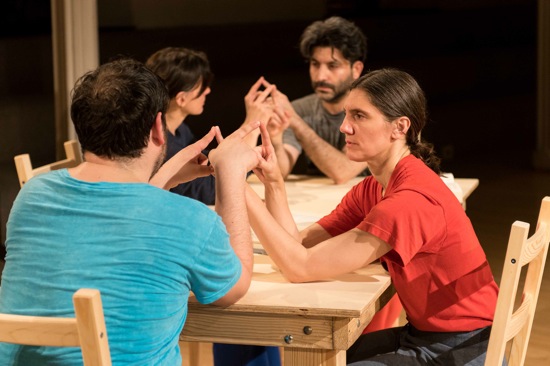
Juliette Mapp’s Luxury Rentals. (L to R): Levi Gonzales, Jimena Paz, Kayvon Pourazar, and Juliette Mapp. Photo: Ian Douglas, courtesy of Danspace Project
Once in a while you go to a dance performance and think you’re in a mysterious world, whose inhabitants are familiar to you. . .and yet. . .not. You think about them, ask yourself questions. Then you try to stop asking questions and just watch what they’re doing. That’s how I felt during two recent, deeply absorbing works: Juliette Mapp’s Luxury Rentals at Danspace St. Mark’s and Beth Gill’s Catacomb at the Chocolate Factory. Luxury Rentals involves only four dancers and Catacomb five, but in both, one member of the cast arrives late.
One striking thing about Mapp’s work is how tender the dancers are with one another. Levi Gonzalez, Kayvon Pourazar, and the choreographer begin sitting in a close circle on the floor, each rhythmically and rapidly hitting a book against the wooden surface, pausing (perhaps to turn a page) and passing the book on. After a while, they begin to touch one another gently but firmly—a hand to someone’s cheek, a hand to someone’s knee.
That’s the overture, after which Mapp welcomes us, indicates the exits in case of fire, and asks that we turn off our cell phones. Her first foray into dancing, however, is anything but officially gracious; she’s sensuous, sexy, and wants us to know that. A taped song is playing. I make out words that sound like “Mexican sun,” but the lyrics of the song called “Under the Mexican Sun” never mention that hot solar phenomenon. So either I heard the words incorrectly or another song lurks in the wings. [P.S. Okay, so I finally listened to Daft Punk’s “Get Lucky,” and I still hear “Mexican Sun,” even though Pharrell Williams is mouthing, “She’s up all night to the sun/I’m up all night to get some.”]
A table. Four wooden chairs. Over the course of Luxury Rentals, they will be rearranged many times, perhaps, because as the spoken text and a program note reveals, the several stories that Mapp will occasionally tell—personal ones and those that she knew of and rendered personal—took place in two parts of Brooklyn: Williamsburg, where she lived for years, and Bedford-Stuyvesant, where her son went to pre-school. The furniture also represents a conference table at which Mapp once sat, and at which now, she and Gonzalez move from chair to chair, gradually slumping into fatigue as they go.
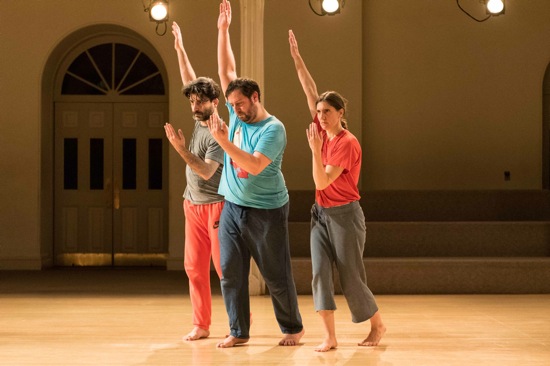
(L to R): Kayvon Pourazar, Levi Gonzalez, and Juliette Mapp in Mapp’s Luxury Rentals. Photo: Ian Douglas, courtesy of Danspace Project
When Gonzalez’s head hits the table, he raises a pointed index finger; she touches her index finger to his. This gesture will be repeated several times, leading to more elaborate variations as the evening progresses. This is not just a game you might play with your kid; the performers seem to be building a structure analogous to debate—agreements arrived at only after many twists and turns.
Interrupting one of the stories that Mapp tells, the dancers push their chairs away from the table with their feet, sink to the floor, help one another up. For the most part, she talks quietly— you can barely hear her (this is deliberate)—but this time she impersonates the enraged driver whose van smashed into “her” car and who shouted threats (“I’m gonna kill you!”). She also quotes the thought-provoking title of an influential New Yorker essay by George S. Trow about power, isolation and commercialism: “The Context of No-Context.”
The dancing itself seems to promise a better world—or one that exists side-by-side with this one. To the music of guitar and harmonica, the three step within a wide-legged, resilient stance. Without aggression, they look bold and convinced, yet flexible enough to dodge imagined blows (one position they occasionally assume, hints vaguely at a fencing stance). They’re in synchrony enough to lift one leg, grab it, and hold it up, to bend low and let their hands dangle, to sway. Their movements become increasingly complex. Like thinking.
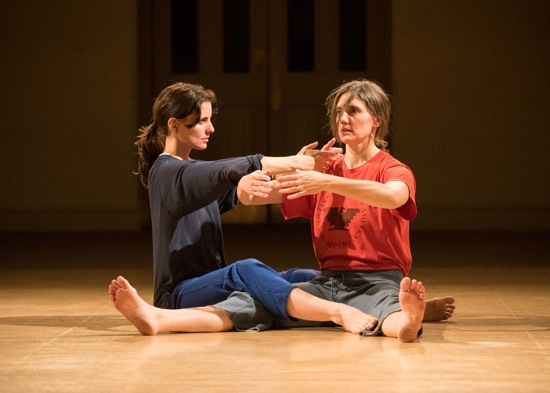
Jimena Paz (L) and Juliette Mapp in Mapp’s Luxury Rentals. Photo: Ian Douglas, courtesy of Danspace Projects
When they’re seated again at the table, reading, Jimena Paz enters unobtrusively and sits on the sidelines, watching them. What are they reading? Mapp says her book is My Struggle (hers or Knausgård’s?). Pourazar at first remains silent, then shows the cover of his book. It’s Anna Karenina. They get sleepy again. But when Paz joins them, they can pair up for conversations with neatly connecting and reconnecting fingers and accompanying body accommodations.
We hear only one side of the dialogue that relates to an apartment of Mapp’s that had no heat in winter. One frigid day, when she and her son were on a warm subway train, he asked if they could just keep riding for a while longer. Another (?) time, while the two were riding the B to catch the M train, a young woman jumped or fell onto the tracks. I can’t recall in what context these words arose: “I’m a bad son.” Context/no context?
Whatever these people do resonates against a sense of life in the city. They sit at the table and converse quietly, lie on the floor, get up, stumble, walk on their knees. Mapp, under the table, curls into a fetal position; Gonzalez lowers himself to join her as best he can and hold her hand. Joe Levasseur’s lighting turns chill or glaring or dim, but very subtly.
Near the end, the table set on one of its ends becomes a screen for John Jesurun’s video of the performers. Seen up close and in black-and-white, their need of, or concern for, one another becomes more palpable. A hand can caress another’s face or perhaps it is simply reaching out of solitude to feel what else is there. A blurry, slowed-down voice is heard.
I thought Luxury Rentals (a term all too common in the New York Times’ real estate ads and ironic in this context) was about to end. But there was a little more moving of tables and chairs to be done, more collapsing, more building finger structures, and more song lyrics that sounded like “Mexican sun,” but probably weren’t. I left St. Mark’s loving these people.
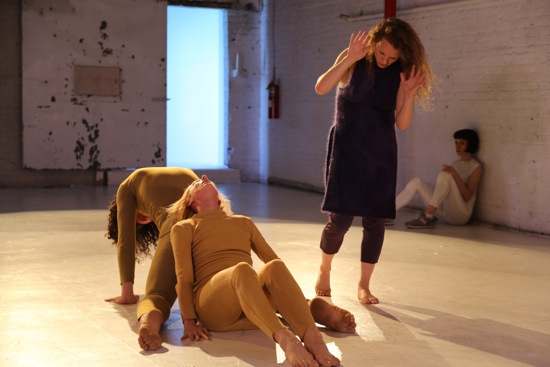
Beth Gill’s Catacomb. (L to R): Stuart Singer and Heather Lang (on floor). Marilyn Maywald Yahel (standing), and Jennifer Lafferty at back. Photo: Brian Rogers
Gill’s new work, like Mapp’s, is enigmatic, but much sparer. Watching Catacomb, fascinated, is like stumbling into a scene in an unfamiliar culture; you think you know what is going on, but it’s best not to be sure. There’s something surreal about the piece, and that includes the wonderfully sensitive lighting that Thomas Dunn creates and the often eerie music by Jon Moniaci for theremin, laptop, and two voices (Rachel Kara Perez and Peter Sciscioli).
The title itself is intriguing. Perhaps Gill means catacomb as a repository for preserving remnants—in this case, memories or dreams. The Chocolate Factory becomes a white box that reveals architectural elements usually concealed. From where we sit at the far, narrow end of the second floor space, we face an open elevator shaft, an equally mysterious portal, and the half-open sliding door through which we entered—all of them glowing.
We are not the only ones watching Heather Lang and Stuart Singer. Jennifer Lafferty, wearing a white top and leggings, wanders from spot to spot, close to the walls, even seeming at times to read them. She sits pressed against one white brick wall. Later, she will lie there and turn her head away from the action. In the beginning, Singer lies face down, legs spread, in a pool of light; Lang reclines between his legs—his buttocks her pillow, his legs like the arm rests of a comfortable chair. A low hum starts up. Singer hoists himself up a bit on his hands and begins slowly to inch backwards (toward us) over Lang. Her face disappears beneath his crotch, then her bent leg straightens to pass under the opening between his legs. He’s never completely free of her, and almost immediately works his way back to his original position, his body grazing her nose as her face reappears from between his legs.
Silence. Long pause. Lafferty leans against a radiator. Singer begins his passage again. This time, I notice that, at one point, Lang reaches up and strokes his long, curly black hair. I see that he lifts and lowers and lifts his hips again—just once. The two repeat their actions many times, and pauses between Singer’s backing up and moving forward over his partner gradually disappear. Then—again, a number of times— he begins hooking an arm under her and turning her sideways as he lifts her and himself a bit higher, then resumes the original position.
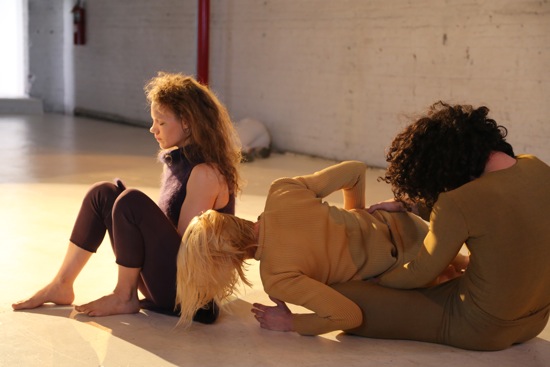
(L to R): Marilyn Maywald Yahel, Heather Lang, and Stuart Singer in Beth Gill’s Catacomb. Photo: Brian Rogers
The mingling of almost mechanical precision with highly stylized sexual heat is startling. Gill gives us—and, apparently, Lafferty—a lot to think about. Through this, the sound has started up again and gotten much louder. Now a head of curly, fair hair appears at the bottom edge of the elevator shaft and waits there for a few seconds, before Marilyn Maywald Yahel hoists herself up to sit in full sight. By now, Lang and Singer have moved into sitting positions, leaning to one side, still connected. Yahel works her way between them and then sinks down to face us, her eyes at first closed. Lafferty moves close to peruse them, but never too close.
There’s a ringing sound, and a high voice singing. Images invade my mind and cohere strangely. Yahel touches Lang briefly, then closes her hands into fists. Stewart walks away from us, bent over, Lang arched backward over his back. On his feet and dancing, he holds his crotch. He and Lang stand, bent over, hanging their heads. Yahel—sinking into a squat, throwing a leg up behind her, running in a crouch—can seem to be orchestrating something or trying to separate (or join?) the pair. Lafferty shakes. Stewart falls backward, Lang now in his lap. Organ tones that have arisen repeat a six-note passage over and over. When Stewart and Lang have separated and finished some big, bold dancing, they stand erect, rotating slightly, looking as inert as wax figures, Yahel crawls between them, gazing upward and beyond us, while the music becomes tumultuous. Eventually, her mission over, she returns to the invisible elevator and sinks out of sight.
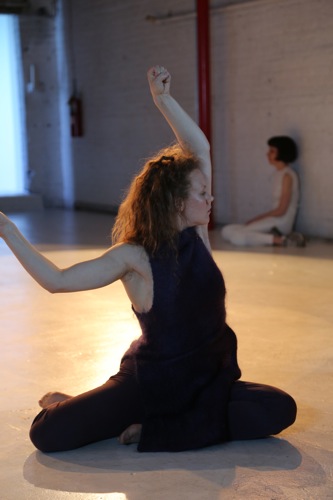
Marilyn Maywald Yahel and (at back) Jennifer Lafferty in Beth Gill’s Catacomb. Photo: Brian Rogers
I find myself thinking of the biblical Adam and Eve, their newness to copulation, their shame, their expulsion from paradise, and the angel with the flaming sword who prevents them from returning. It is true that they eventually leave the space, but only halfway. Stewart sits close to the partly open exit door; Lang crawls out, leaving her legs behind. What other scenarios are passing through the minds of the spectators among whom I sit?
While Lang and Stewart remain motionless, Lafferty comes to vivid and temperamental life. She smacks against a wall and falls, she lifts a leg and scrapes it down the wall. A tall, very slender woman and an arresting dancer, she flings her legs high behind her as she charges again the confines of the space. A low hum becomes explosive, a veritable, but not realistic storm. A slim ribbon of light that appears along the crack between one wall and the floor passes over Lafferty’s furiously moving body.
It’s only after she collapses—maybe sleeping—that, in a suddenly warmer light, Maggie Cloud appears in the door-sized opening. In her brief appearance, she makes odd little skips and low jumps and hops—emerging and then backing out of sight again. In whose fairy tale, does she figure? Or whose sleepless night? The last moments, however, belong to Lafferty, making big, widespread movements, turning her hands into claws. A rumble, blue light. Blackout.
Gill is so fastidious, so intensely aware of form, that even recklessness seems controlled. There’s scarcely a sound or a movement in the audience until close to the end of Catacomb. The dance is like a jigsaw puzzle— an elegant, winnowed down collection of exceptionally vivid pieces. Maybe you want to piece them together. Maybe you don’t.

Early readers of this may have noticed my “Mexican Sun” perplexity (and error). I made the correction, although God knows Pharrell Williams doesn’t publicity from me.